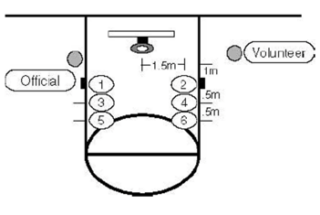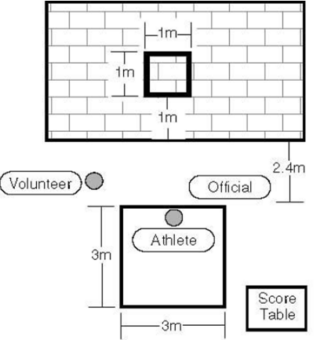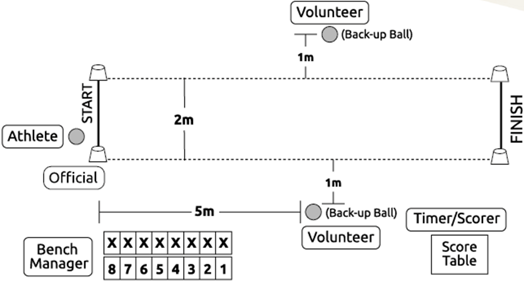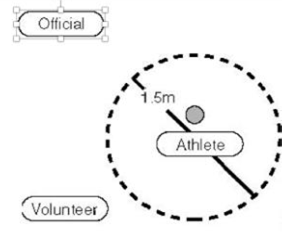Basketball Rules
Valid through 2025
Special Olympics New Hampshire has created this set of rules based on the rules outlined by Special Olympics International as well as the Federation Internationale de Basketball (FIBA), which is the international governing body for Basketball.
These rules shall be used to govern all Special Olympics New Hampshire Basketball competition through the end of 2025 when we next review these rules.
Events Offered
- Individual Skills: Level 1 and Level 2
- Half-Court Traditional 3 v 3
- Half-Court Unified Sports 3 v 3
- Full Court Traditional 5 v 5
- Full Court Unified Sports 5 v 5
Registration
- Athletes will compete in one event.
- We strongly recommend a full-court team’s roster have a minimum of 10 players and a maximum of 15.
- Full-Court Unified Teams are strongly recommended to have at least six partners on their roster.
- We strongly recommend a half court team’s roster have a minimum of 6 players and a maximum of 9 players.
- Half-Court Unified Teams are strongly recommended to have at least four partners on their roster.
- A team’s roster may not change from area assessment to state competition.
- All teams must have a non-playing coach.
- The Local Program must select a level for each team when registering.
| Level | Traveling | Double-Dribble | Full-Court Press | Three Seconds | Clock Management |
| 1 | Enforced | Enforced | Anytime | Enforced | Stop time |
| 2 | 1 to 2 steps only | No unfair advantage | Last 2 minutes of each half | Not in effect | Running time, except for the last two minutes of each half and any overtime period, which will be stopped time |
| 3 | No unfair advantage | No unfair advantage | No pressing | Not in effect | Running time |
If the team is competing in Unified Sports competition, they must also select a category. Both level and category should be entered into the level field in Agon (format: Level-Category).
| Category | Unified Model | Description |
| 1 | Competitive | Unified Sports partners have full participation (athletes & partners shoot) |
| 2 | Player Development | Unified Sports partners have restricted participation (only athletes shoot) |
| 3 | Recreational (3 v 3 ONLY) | FOR LEVEL 3, 3 v 3 ONLY. Unified sports partners manage and facilitate play, they do not shoot. At this level, athletes who use devices may participate. |
- For individual skills athletes, a qualifying score must be entered for area assessments that equal the sum of all five event scores (see pages 4-6 for ISC scoring).
- While Individual Skills is one event, two levels are present:
- Level 1 involves the 10’ basket for the Spot Shot as well as the other four events.
- Level 2 involves the 6’ basket for the Spot Shot as well as the other four events.
- Level 1 and Level 2 will be divisioned separately, according to level and assessment scores.
- When registering, you must select Level 2 if the athlete is using the 6’ basket or Level 1 if he/she is using the 10’ basket.
Divisioning
- The goal of the Area Assessment competition is to ensure teams are in the appropriate division in each category. During Area Assessments, games will be played against teams in the same category as necessary to seed all teams. Games may be shortened.
- The goal of the assessment round for individual skills is to obtain qualifying scores for athletes participating in Individual Skills State Games competition and to ensure that athletes are in the appropriate division.
- The State Games will be divisioned based on the results of the assessment round with consideration of the previous year’s State Basketball Tournament results.
Equipment
- A women’s regulation size basketball will be used for all competition (Individual Skills, Unified and Traditional 5v5 & 3v3).
- Circumference: between 724 millimeters [28.5 in] and 737 millimeters [29 in] Weight: between 510 grams [18 oz] and 567 grams [20 oz]
- The baskets shall comprise the backboards, rings, and nets. For 5v5 and 3v3 competition, the basket ring is normally 3.05 meters (10 feet) above the floor.
- Mouth guards are recommended for all players.
- Individual Skills:
- Spot Shot: Two official women’s basketballs, red floor safe tape, measuring tape, and regulation goal with backboard. Both a 10’ basket (Level 1) and a 6’ basket (Level 2) will be offered for the Spot Shot. Separate divisions will be identified by the basket height for equitable competition.
- Ten-Meter Dribble: Three regulation size women’s basketballs, four traffic cones, red floor safe tape, measuring tape, whistle and stopwatch.
- Target Pass: Two regulation size women’s basketballs, flat wall, red floor safe tape and measuring tape.
- Bounce Pass: Two regulation size women’s basketballs, measuring tape, and red floor safe tape.
- Speed Dribble: Measuring tape, red floor safe tape, one regulation size women’s basketball, stopwatch, hand-held counter and whistle.
Uniform
- All players must wear identical basketball attire (uniform consisting of shorts and shirt) with identifying number and flat rubber sole athletic shoes.
- The number must be on the back of the uniform and the front of the uniform and be at least 6 inches in height.
- Legal numbers are 0, 1, 2, 3, 4, 5, 00, 10, 11, 12, 13, 14, 15, 20, 21, 22, 23, 24, 25, 30, 31, 32, 33, 34, 35, 40, 41 42, 43, 44, 45, 50, 51, 52, 53, 54, and 55. Only 0 or 00 may be used on a team, not both. No team members wear the same number.
- Team uniform shirts and shorts must be identical in trim color and style.
Competition
Full Court 5-on-5
- Each team shall have a non-playing head coach.
- The game will consist of four, six-minute quarters with 1- minute break between quarters 1 and 2 as well as 3 and 4 and a 2-minute intermission at halftime.
- If the score is tied at the end of playing time in the fourth quarter, the game shall continue with as many extra periods of 3 minutes as is necessary to break the tie.
- Each team will have two, 30-second timeouts per half.
- For Unified Sports, there is to be no more than 3 athletes and 2 partners on the court at all times.
Half-court 3-on-3
- The game will consist of two, 10-minute halves with a 2-minute intermission between halves.
- The game will start with coin toss for possession. The team that wins the coin flip decides whether it takes the ball or leaves it, in order to get in potential overtime. In overtime, first team to score wins.
- There is no jump ball. All jump ball situations, the ball shall be awarded to the defensive team.
- If the score is tied at the end of the regulation time, the game shall continue with as many extra periods of 3 minutes as is necessary to break the tie. The overtime period will begin with a coin toss for possession.
- Teams change possession of the ball after made field goals. However, if a player is fouled in the act of shooting and makes the basket, the field goal is credited, and the offended against team retains possession of the ball.
- The throw-in spot in all cases (fouls, violations, out-of-bounds, made field goals, timeouts) will be behind the foul line extended at a designated spot within the restraining circle at the top of the key. This procedure is used for all fouls, violations, timeouts, out-of-bounds and made field goals. The in-bounder will be at the designated spot; all other players are within the half-court boundaries. After the ball is put into play by passing to a teammate, any offensive player can shoot.
- On any change of possession, the team which just gained possession of the ball must take the ball back behind the foul line extended before shooting. In taking the ball back, either the ball or the foot of the player in possession must touch the foul line extended or the area behind it.
- A violation has occurred when the defense, who has just gained possession of the ball, attempts a field goal without taking it back behind the foul line extended.
- Substitution may be made on a dead ball. When one team makes a substitution, the other team must be given an opportunity to substitute as well. Players entering the game must report to the scorer’s table and be beckoned into the game by the referee.
- Each team will have two, 60 second timeouts per game. An additional timeout per team will be allowed for each overtime period.
- When a timeout is called, the clock will be stopped.
- For Unified Sports, there is to be no more than 2 athletes and 1 partner on the court at all times.
Individual Skills COMPETITION
- Individual Skills provides meaningful competition for athletes with lower ability levels. It is not for athletes who can already play the game.
- Five events comprise the Individual Skills Contest: Spot Shot, Ten-Meter Dribble, Target Pass, Bounce Pass, and Speed Dribble.
- Level 1 will involve the10’ basket.
- Level 2 will involve the 6’ basket which is offered for the lowest ability athletes who are unable to reach the 10’ basket when shooting.
- Lower ability athletes who need to use the 6’ basket will be divisioned separately.
- The athlete’s final score is determined by adding together the scores achieved in each of the five events using the scoresheet found on page 7 of these rules.
Event #1: Spot Shot
- Purpose: To measure an athlete’s skill in shooting a basketball.
- Description: Six spots are marked on the floor. Start each measurement from a spot on the floor under the front of the rim. The spots are marked as outlined below. The athlete attempts two field goals from each of six spots. The attempts are taken at spots #2, #4, and #6 and then at spots #1, #3, and #5.
- #1 & #2 =1.5M (4.9 feet) to the left and right plus 1M (3.3 feet) out.
- #3 & #4 =1.5M (4.9 feet) to the left and right plus 1.5M (4.9 feet) out.
- #5 & #6 = 1.5M (4.9 feet) to the left and right plus 2M (6.6 feet) out.
- Scoring:
- For every field goal made at spots #1 and #2, two points are awarded.

For every field goal made at spots # 3 and #4, three points are awarded
Event #2: Ten-Meter Dribble
- Purpose: To measure an athlete’s speed and skill in dribbling a basketball.
- Description: A 1.5M x 10M (4.9 feet x 32.8 feet) rectangle is marked off using red floor safe tape. A traffic cone is placed at each corner. The athlete begins from behind the start line and between the cones. The athlete starts dribbling and moving on the signal “Go”. The athlete dribbles the ball with one hand for the entire 10M (32.8 feet). The athlete must cross the finish line between the cones and must pick up the basketball to stop the dribble. The athlete is given two trials.
- If an athlete loses control of the ball, the clock continues to run, and the athlete can recover the ball. If the ball goes outside of the rectangle, the athlete can either pick up the nearest back-up basketball (located near the start line) or recover the errant ball to continue the event.
- An athlete who uses a wheelchair must alternate taking 2 pushes, followed by two dribbles for legal dribbling.
- Scoring: The official will say “Ready” and follow with “Go”. The athlete begins the event on the signal “Go”, and time will “run” from when the athlete crosses the start line to when he/she crosses the finish line between the cones and picks up the basketball to stop the dribble.
- A one-second penalty will be added every time the athlete illegally dribbles (i.e. two-hand dribbles, carries the ball, etc.).
- The athlete will receive two trials. Each trial is scored by adding penalty points to the time elapsed and converting the total to points based on the Conversion Chart.
- The athlete’s score for the event is his/her best of the two trials converted into points (in case of a tie, the actual time will be used to differentiate place, in the entire competition).


Purpose: To measure an athlete’s skill in passing a basketball to a specific target.
- Description: A 1M (3.3 feet) square is marked on a wall using red floor safe tape. The bottom line of the square shall be 1M (3.3 feet) from the floor. A 1.5M (4.9 feet) square will be marked on the floor and 2.4M (7.9 feet) from the wall. The athlete must stand in the square.
¡ The front wheel of an athlete’s wheelchair may not pass over the line. The athlete is given five passes.
- Scoring: The athlete may receive up to 4 points for each pass (20 points total)
¡ 3 points for hitting the wall inside the square OR 2 points for hitting the lines of the square OR 1 point for hitting the wall but not in or on any part of the square.
¡ Additionally, athlete receives 1 point for catching the ball without going out of the square.
Event #4: Bounce Pass
- Purpose: To measure an athlete’s skill in passing a basketball.
- Description: A 1M (3.3 feet) square is marked on the floor using painter’s tape. A line is marked 1M (3.3 feet) from the top of the square (receiving line). A second line is placed 2M (6.6 feet) from the bottom of the square (passing line). A receiver should stand behind the receiving line. The athlete must stand behind the line at the bottom of the square (passing line). The athlete will bounce pass to the receiver. The athlete is given five passes.
- The front wheel of an athlete’s wheelchair may not pass over the line.
- Scoring: The athlete may receive up to 4 points per pass (20 points total).
- 3 points for hitting the floor inside the square OR 2 points for hitting the lines of the square OR 1 point for passing the ball using a bounce, but not in or on any part of the square.
- 1 additional point is awarded for passing the ball from at or below the shoulders.
- The athlete’s score will be the sum of the points from all five passes.

Event #5: Speed Dribble

- Purpose: Dribble the ball as many times as possible during a 60-second time period.
- Description: Mark a 1.5M (4.9 feet) square. athlete starts and stops dribbling at the sound of the whistle. There is a 60-second time limit.
- Athlete may use only one hand to dribble.
- Athlete must either be standing or sitting in a wheelchair or another type of chair with similar dimensions while competing.
- Athlete must stay in the designated square while dribbling.
- If the basketball rolls out of the circle, it may be handed back to the athlete who continues to dribble. If the basketball rolls out of the square three times, time is stopped.
- Scoring
- Points are given based on the number of legal dribbles within the 60 seconds. Points will be given following the grid below:
Dribbles PTS Dribbles PTS Dribbles PTS Dribbles PTS
0 0 16-20 4 36-40 8 56-60 12
1-5 1 21-25 5 41-45 9 61-65 13
6-10 2 26-30 6 46-50 10 66-70 14
11-15 3 31-35 7 51-55 11 71 + 15
Disqualification
- Player dismissal and forfeits
- Continued misconduct or flagrant and intentional fouling will result in player dismissal.
- Player dismissal at assessments may result in State Games suspension.
- In half-court 3-on-3 competition, you play with three players on the court at a time. Unified 3-on-3 court make up must always be 2 athletes, 1 partner. Failure to adhere to the required player count and/or athlete to partner ratio results in a forfeit for that game.
- In full-court 5-on-5 competition, you play with five players on the court at a time. Unified 5-on-5 court make up must always be 3 athletes, 2 partners. Failure to adhere to the required player count and/or athlete to partner ratio results in a forfeit for that game.
